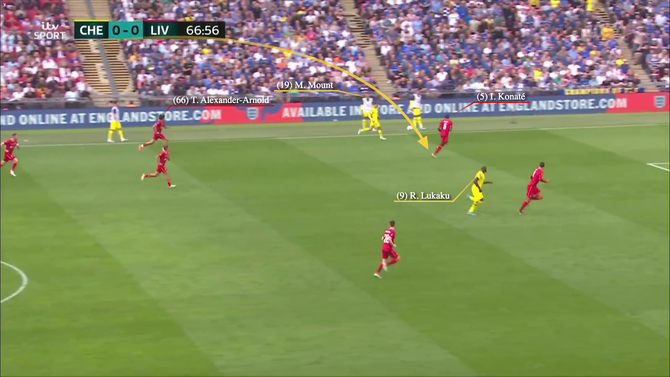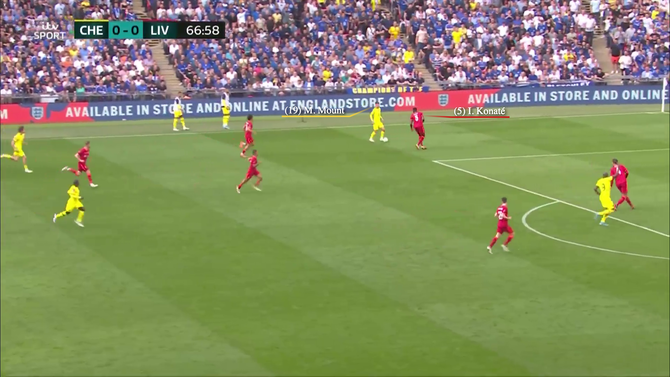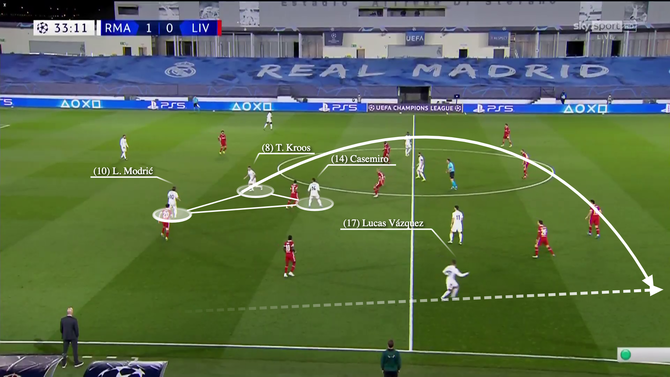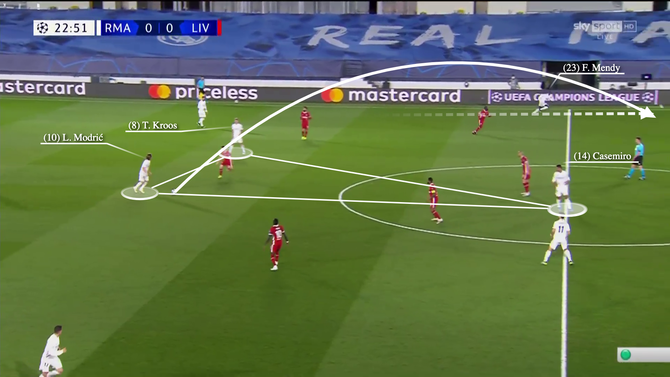
After 124 games, 379 goals and three absolutely audacious Real Madrid comebacks, the end is in sight. On Saturday at 3 p.m. ET on Paramount+ and CBS two of the most prestigious clubs in European footballing history — Madrid and Liverpool — face off in Paris to determine the Champions League winners.
It is a clash rich in recent history, the 2018 final and the 2021 quarterfinals most notably, both of which could provide some clue as to how things will play out. Here’s what to keep an eye out for:
Konate gives Alexander-Arnold license to shine
If there is one part of the pitch that promises to be decisive at the Stade de France it may well be the Liverpool right channel and whatever spaces are occupied by Trent Alexander-Arnold. It is from that position that Jurgen Klopp’s side has won so many games, but it should not be forgotten that every once in a while their front-footed right-back leaves holes in the backline that are decisively exploited by his opponents.
When these two teams met in last year’s quarterfinals Alexander-Arnold might have done better on each of Real Madrid’s three first leg goals, two scored by Vinicius Junior and the other from a misjudged header back towards his goalkeeper. This was perhaps as low a point as the young defender has suffered in his career so far, one of those nights where it is painfully apparent to a global audience that there is one player on this pitch who is being remorselessly targeted until he cracks. Madrid’s pass map from that night shows a string of long balls aimed into the Liverpool right with Ferland Mendy and Vinicius consistently on the receiving end.
Things have changed in the past year. Alexander-Arnold has improved as an individual defender this season and there should be absolutely no question that any deficiencies he brings to Liverpool’s defense are more than compensated for with the game warping impact he has at the other end of the pitch. Equally, the Vinicius of that night, what appeared to be the moment he announced himself on the main stage, has been a frequent sight on this season’s biggest occasions. There is only one player who ranks more highly than Alexander-Arnold for chances created, expected assists and actual assists in this season’s Champions League. It is the young forward he will likely be pitted against on Saturday night.
What might make life easier for Liverpool this time out is that it will not be Nathaniel Phillips, a decent center back thrown into a footballing Mariana Trench by a spate of injuries last season, on Alexander-Arnold’s inside shoulder but Ibrahima Konate. At the Estadio Alfredo Di Stefano Phillips was thrust into difficult covering situations for Madrid’s goals, particularly Vinicius’ opener off a long pass by the peerless Toni Kroos, and could not cope. There are no guarantees that Konate would be able to stop similar problems if they came his way, but his covering in the spaces behind his full back has stood out in recent weeks.
In the FA Cup Final, for instance, there were perhaps half a dozen moments like the one above. Alexander-Arnold had pushed upfield to add to Liverpool’s attacking numbers and Chelsea attempted to exploit with rapid balls over the top to either Christian Pulisic or Mason Mount. In theory this is quite a dangerous position for the Reds. Andrew Robertson on the near side might just about be able to aid Virgil van Dijk against Romelu Lukaku should he be required (debatable, I know), but the cavalry might not arrive in time.
Konate seems to understand that. He did not commit to any rash moves in an attempt to stop the move there and then; his body positioning is perfect for the situation, encouraging Mount to head down towards the byline but keeping in close enough proximity that if his opponent tries to nudge the ball ahead he can step in. Similarly the pass to Lukaku never really emerges as an option. In the end what looks like a dangerous moment soon becomes nothing at all.
The 22 year old is not flawless in this regard; there were moments when Raul Jimenez gave him difficulties on the final day of the Premier League season. It would be a bold prediction indeed to assume that he can lock down Vinicius every time he gets away from Alexander-Arnold. But then it is not really about that for Liverpool. Their priority will not be locking down their right flank defensively, but ensuring it is well guarded enough that one of world football’s outstanding playmakers can focus on what he does best in attack. If Konate starts, not necessarily guaranteed when Joel Matip is the alternative, but still the most likely scenario, then Jurgen Klopp may feel his weak point is sufficiently well protected.
Craving even more coverage of the world’s game? Listen below and follow ¡Qué Golazo! A Daily CBS Soccer Podcast where we take you beyond the pitch and around the globe for commentary, previews, recaps and more.
Madrid long balls don’t work quite as well
Though it certainly feels like the last Champions League tie between these two holds some clues as to what will happen in Paris, there are of some caveats to this. For one, the Liverpool defense will look radically different, but, of course, there is also a different manager in the Madrid dugout. To what extent will Carlo Ancelotti look to replicate what his side did so well under Zinedine Zidane? It is hard to know, but one thing we can be sure of is that the veteran Italian is so ego free that he will not instinctively bristle at the idea of simply repeating what worked last time out.
As such, look for a reprise of the devastating long balls that Madrid used to unleash their wingers in last season’s quarters. Those two games saw Los Merengues attempt a higher proportion of long passes than in any other game they have played over the past two seasons of Champions League football, 15.5 percent in the first leg (when they were at their most effective) and 18 percent in the second. That second figure is almost double what this team average in European games in 2020-21 and 2021-222.
They might well enact this approach by flipping their midfield as they did a year ago. For Zidane dropping Luka Modric and Toni Kroos back as Casemiro pushed forward came with two advantages. First of all, when the Liverpool press came it helped to have his two most technically secure players nearer to the danger zone, ready to take the passes off their defense or to shuffle away from an opponent.
That was more a theoretical advantage than a practical one, however. The pressure never really came on Kroos and Modric, who instead could take a breath and ping passes like these to their full backs.
In April 2021 Liverpool were running on empty, physically and mentally, and struggling to implement the basic principles Klopp had drummed into them over the previous years. Take that second image, it is not just that Modric has time to pick a pass. Sadio Mane and Mohamed Salah tend to be hugely effective at making their pressing runs in such a fashion as to block off the out-ball to the near side full back, but here the former leaves the escape valve pass to Modric’s right wide open.
This was right in the middle of what was a profound lull in form for Mane, inexplicable even to him. Meanwhile in this game Naby Keita, often Liverpool’s most effective pressure valve from midfield, struggled so greatly that he did not even reach the half time whistle. It was the sort of performance that seemed to spell doom for the Guinean’s career at Anfield. But, he has since responded with a vastly improved 2021-22 campaign in which he averages nearly two more successful pressures per 90 minutes, leading the way in Klopp’s squad in that category. Meanwhile Mane has gone from the Liverpool bench to being labelled a Ballon d’Or frontrunner. The machine has clicked into gear. These players are back to their best and many of them have a point to prove.
Salah gets his revenge
This column likes nothing more than to pontificate around tactical adjustments or to dive deep into the weeds of expected goals. But heck, sometimes you just have to look at a game and say “yeah, he’s going to be up for this.” Salah against Real Madrid? That’s one for sure.
For those unaware of the circumstances that led to the animus between Salah and Europe’s most successful club, one need only cast their mind back four years to the Champions League final in Kyiv. A throw in into midfield by Alexander-Arnold for his teammate to chase and for a moment it looks like Salah is away from Sergio Ramos. The Madrid captain would not let him get away so easily, locking his arm around his opponent and spinning him to the ground.
Salah hits the deck and so does Ramos, the Liverpool forward’s right arm tucked in his left. He was never going to be able to continue. With less than half an hour gone in the game, Klopp’s best attacker was forced off with tears in his eyes. He would not return and even though he would fight his way through the pain to play at that summer’s World Cup he was a shadow of his best self. Little wonder he called this game a “revenge mission” at the Football Writers’ Association awards. He and his Liverpool teammates “have a score to settle.”
One might query whether Salah is in the right state to do that. After all recent weeks have not been kind to the Egyptian, his late strike against Wolves at the weekend just the fourth time he has found the net in 19 games since the EFL Cup Final. Since rushing back from the Africa Cup of Nations — four days after losing the final he came off the bench for Liverpool against Burnley — the output has dried up.
The underlying numbers, however, are unchanged. Indeed his non-penalty expected goals (xG) per 90 minutes of Premier League and European football have actually crept up since he came back into the fray in February, from 0.63 to 0.66. His expected assists have rocketed from 0.17 to 0.3. It is just that the ball isn’t going into the net right now, his shooting goals added (a metric that assesses how accurately a player has hit the target) going from 3.2 to -4.2.
That last number points to a finishing slump without really divining its root cause. For that one could come up with a variety of explanations, some convincing (the longer the drought goes on the more determined Salah becomes to end it, causing him to snatch at chances he would usually bury), others less so (but what about if ghosts did take his shooting powers?). About the only thing we can know for certain with slumps like this is that they tend to come to an end.
There is no cause for panic in this cold streak in front of goal. Watch Salah and he just looks a bit knackered, no great surprise given his fixture load. The Champions League final will be his 60th game for club and country this season and his two lengthiest breaks of 2022 so far have involved travelling to Egypt to prepare for critical international fixtures. He just needs time to recuperate; come Saturday he will have played just over half an hour of competitive football in a fortnight. In all that time he will surely have had Madrid, and payback, on his mind.





